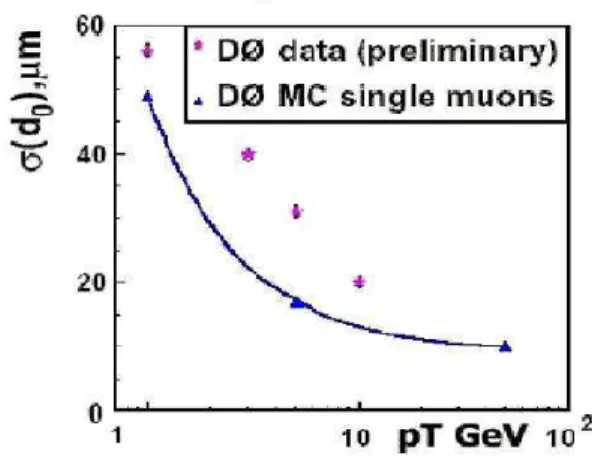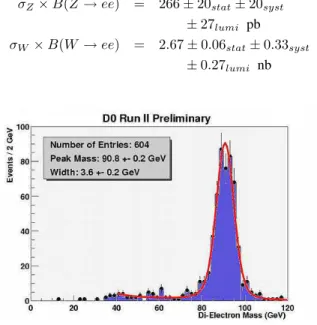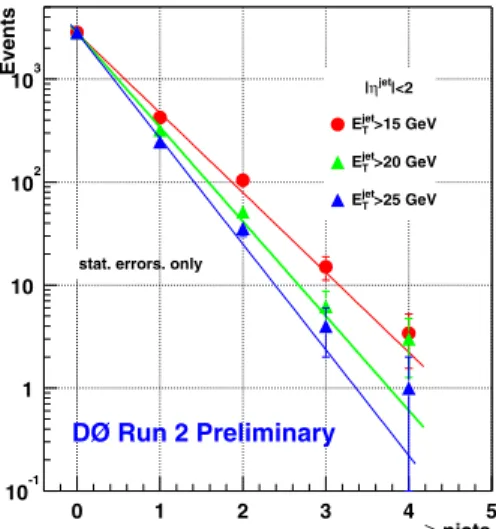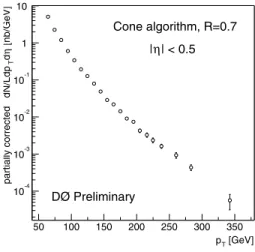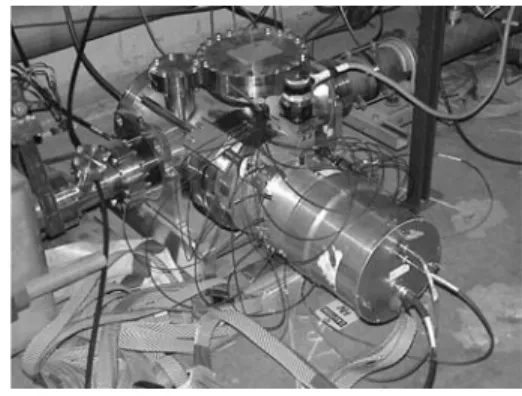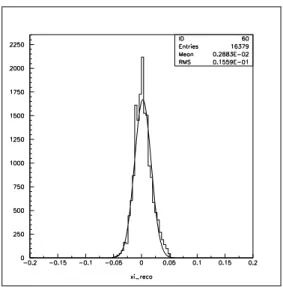Preliminary Results from DØ Run II Data
Wagner de Paula Carvalho (for the DØ Collaboration)
Instituto de F´ısica, Universidade Estadual do Rio de Janeiro, Rua S˜ao Francisco Xavier 524, 20550-900, Rio de Janeiro, RJ, BrazilReceived on 01 August, 2003.
We present recent physics results from the data collected by the DØ detector in this early stage of Run II of the Tevatron proton-antiproton collider. Emphasis is given to the Forward Proton Detector, a new subsystem that will enable detailed studies of diffractive phenomena at Tevatron.
1
Introduction
The first period of running of the Fermilab Tevatron (called Run I), lasting from 1992 to 1996, was very successful in producing high quality physics results.
The DØ Collaboration [1], one of the two broad inter-national collaborations operating in the collider ring (The other one being the CDF - Collider Detector at Fermilab), had a extensive and well succeed physics program that gave rise to more than one hundred physics papers published in world class publications. Topping its achievements is top quark discovery (announced at the same time by CDF), but a extensive list of DØ Run I physics highlights can be found in [2].
The ongoing Run II of the Tevatron was planned to sig-nificantly extend this physics program. The accelerators and detectors upgrades should allow the two collaborations to greatly improve over and refine many of the measurements performed with Run I data. New measurements shall also be made possible and, perhaps, some new physics become accessible.
The DØ Run II menu includes topics like: make pre-cision measurements of the top quark properties;tt spec-troscopy as sign of new physics; refine measurements on the electroweak sector, especially gauge boson couplings and
W mass; mixing, CP violation andbhadron spectroscopy in thebsector, as well as extendb-quark production mea-surements to new kinematic regions; search for new phe-nomena (leptoquarks, SUSY, technicolor, etc.); extend the jet measurements to further constrain proton structure func-tions; study a variety of diffractive phenomena (hard tion, double diffraction, double pomeron exchange, diffrac-tive heavy flavor production); search for glueball states.
2
The Upgraded Tevatron
The Fermilab accelerator complex has gone through a ma-jor upgrade from Run I to Run II. The Antiproton Source and the Booster were improved and the old Main Ring, that shared the same tunnel with the Tevatron, was shut down
and replaced by the Main Injector.
Such improvements were aimed to increase Tevatron en-ergy and luminosity. The center of mass enen-ergy went up slightly from 1.80 to 1.96GeV, which is enough nevertheless to increasettproduction cross section by nearly 40%. The beam bunch structure has changed, going from 6 bunches of protons×6 bunches of antiprotons to 36×36. The time interval between successive bunch crossings has shortened from 3.5µs to 396ns and the instantaneous luminosity is ex-pected to increase from typically 1.6×1030cm−2s−1to a
projected value of8.6×1031cm−2s−1.
The integrated luminosity during the whole Run I was a little above 100pb−1. With all these accelerator changes,
the expected accumulated luminosity for the first phase of the Run II (Run IIa), ending in 2004, is 2fb−1. The
acceler-ator will then be subject to new improvements and the total Run II integrated luminosity should reach 15fb−1.
3
The Upgraded DØ Detector
The DØ Detector [3] was also subject of a major upgrade from Run I to Run II [4].
The old central detector comprised of drift chambers and a transition radiation detector was replaced by silicon mi-crostrip detectors (SMT) and a fine segmented scintillating fiber system (CFT), both placed inside a 2T superconduct-ing solenoid (there was no central magnetic field in the DØ Run I Detector).
Preshower detectors were installed before the calorime-ters to aid electron identification and triggering and to cor-rect electromagnetic energy for effects of the solenoid.
Another major change was the addition of a set of for-ward proton and antiproton detectors. Placed inside Roman pots, ranging from 23m to 59m away from the DØ center, they added to the DØ spectrometer the capability of tagging scattered protons and antiprotons.
Finally, entirely new trigger and DAQ systems had to be designed and installed to cope with the increased event rate of Run II.
Figure 1. Schematic side view of the DØ upgraded detector.
4
Detector Performance
After just a few months of stable operation of most of the detector systems, they seem to be producing good quality data.
The new central detector is having a good performance, approaching some of the designed goals. SMT and CFT de-tection efficiencies are above 97% and 98%, respectively. The impact parameter resolution for tracks reconstructed in the central detector is shown in Fig. 2 and compared to the expected parameterization. One can see a reasonable agree-ment, with only survey alignment taken into account. In-cluding alignment with data should improve the reconstruc-tion.
Figure 2. Measured vs. predicted impact parameter for single muons.
The muon system also seems to be functioning properly and the scintillators time resolution of 2.5ns is proving help-ful in obtaining clean muon samples by removing the out-of-time background.
The calorimeters preserve Run I excellent performance and good energy resolution, with only about 0.1% dead channels out of their 55K readout channels.
5
Physics Results
The Run II started in March, 2001. About 50pb−1have been
delivered so far, with peak instantaneous luminosity reach-ing33.5×1030cm−2s−1. Most of this luminosity was used
for detectors commissioning. The results shown next are based on approximately 10pb−1of physics quality data.
5.1
B-Physics
The first results on B-Physics are related to the production of thebquark.
So far,b-quark production at DØ has been tagged by the presence of muons in the event, which is a characteristic sig-nature of B hadron direct or indirect decay.
Muons are triggered and identified through the signals they leave in the three layers of proportional drift chambers and in the scintillators (2 layers in the central and 3 layers in the forward region). A fit to the reconstructed track seg-ments before and after the magnetized iron toroid gives a measure of the muon momentum.
Due to the large material amount before the muon cham-bers, DØ has the capability of detecting muons inside jets. Fig. 3 shows a preliminary Run IIµ+ jet cross section as a function of the jetET for muons ofpT >4GeV/c detected in the central muon system. The jet algorithm used a cone sizeR ≡∆η2+ ∆φ2= 0.5.
20 30 40 50 60 70 80 90 100
10-4 10-3 10-2 10-1 1
Run 2 Preliminary Data MC
R = 0.5 Cone Jets | < 0.6
jet
η
| > 4 GeV/c µ
T
p | < 0.8 µ
η
| ) < 0.7
µ
R(jet,
δ
E
Jet T [GeV]
d
[nb/10 GeV]
d/
σ
ET
DØ Run 2 Preliminary
Figure 3. Muon + jet cross section.
fromb-quarks can be inferred by fitting the transverse mo-mentum of the muon with respect to the jet axis (prel
T ).The estimatedbcontent in this sample is21.5±4.3%.
J/Ψdecaying in two muons is an important signature of
b-quark production at hadron colliders. Clean signals may be obtained and used to extract inclusive production rates or select exclusive samples. Fig. 4 shows preliminary re-sults onJ/Ψcross section as a function of rapidity for two
pµTthresholds. The data sample corresponds to 4.7pb−1and
contains opposite sign muon candidates reconstructed in the muon system with a match in the central tracker.
Figure 4.J/Ψcross section as a function of rapidity for two
pJ/TΨthresholds.
TheBaverage lifetime for aB → J/Ψ +Xsample, withpµT >2GeV/c andpJ/TΨ >4GeV/c, has also been de-termined, giving the valuecτ = 492±37µm, in agreement with the published value,469µm [6].
5.2
W/Z
So far, the analyses onW andZhave concentrated in the electron decay mode. Electrons are identified as energy clusters in the electromagnetic (EM) calorimeter, option-ally associated with a track. The fractionEEM/Etotal of their energy deposited (using a cone of sizeR= 0.2) in the calorimeter EM section is required to be greater than 0.90 and the shower shape must be consistent with Monte Carlo simulations of the detector. Clusters are also subject to an isolation cut, requiring that the total energy contained within
R= 0.4be less than 1.15EEM. The selection efficiency of these cuts computed from aZsample is0.892±0.026.
CandidateZ events are selected by requiring two EM clusters with ET > 25GeV within |y| < 1.1 while W candidates are required to have only one EM cluster with
ET >25GeV within|y|<0.8and /ET>25GeV. The QCD background has little effect on theZsample but is a major concern for theW sample. Most of this background can be removed by requiring a track match. AZ→eepeak in the dielectron spectrum can be seen in Fig. 5.
Using this set of cuts, preliminaryW andZcross sec-tion measurements were made, based on7.52±0.75pb−1of
integrated luminosity. A complete physics and detector sim-ulation was carried out and data corrected accordingly. The
Z and W production cross sections times branching frac-tions to electrons were determined to be:
σZ×B(Z→ee) = 266±20stat±20syst
±27lumi pb
σW×B(W →ee) = 2.67±0.06stat±0.33syst
±0.27lumi nb
Figure 5. Dielectron mass spectrum showing theZpeak.
These results are plotted in Fig. 6 along with other ex-perimental results and theoretical predictions [7] using CTEQ4M parton distribution functions [8]. Many uncer-tainty sources affecting both measurements are correlated and can be eliminated, at least partially, by computing the ratio of the cross sections:
R=σW×B(W →ee)
σZ×B(Z→ee)
= 10.0±0.8stat±1.3syst.
102 103
1
Center of Mass Energy (TeV) σW, Z
×
B (pb)
DØ and CDF Run2 Preliminary
Center of Mass Energy (TeV) Center of Mass Energy (TeV) Center of Mass Energy (TeV)
pp_→ W+X → lν+X
pp_→ Z+X → ll+X
DØ(e) Run2 CDF(e) Run2 CDF(µ) Run2 DØ(e)
CDF(e) CDF(µ)
UA1 UA2
DØ(µ)
Finally, assuming σZ/σW = 0.2964±0.0047 from theory, the Standard Model (SM) prediction ΓW→eν = 0.2270±0.0011GeV and usingB(Z→ee) = 0.03367±
0.00005from LEP measurements, theW total width can be extracted
ΓW = 2.26±0.18stat±0.29syst±0.04theory GeV, which is in agreement with the SM predicted valueΓW = 2.094±0.006GeV.
5.3
Top Quark
The top quark production at Tevatron may occur in pairs through the strong interaction processesqq→ttandgg→ ttor through electroweak single top processes involving a
W tbvertex. At√s= 1.8TeV the predicted cross sections for pair and single top production are approximately 5pb and 2.2pb, and are expected to increase by nearly the same amount (∼30−40%) at√s= 1.96TeV.
Depending on the decay modes of theW’s that come from thetand/ortdecays, different event topologies may arise. In top pair production, there are three possibilities: if bothW’s decay in leptons then a final state with two highpT leptons, two jets and energy imbalance ( /ET) from the escap-ing neutrinos is expected to be observed; if oneW only de-cays leptonicaly then a final state with a highpTlepton, four jets and /ET is expected; if bothW’s underway a hadronic decay then an all-jets final state with six jets should be ob-served. Searches for single top production at DØ have been restricted so far to the leptonicW decay mode, leading to final states with a highpTlepton, /ETand two or three jets.
njets ≥
0 1 2 3 4 5
Events
10-1 1 10 102
103 ηjet|<2 |
>15 GeV jet T E
>20 GeV jet T E
>25 GeV jet T E
DØ Run 2 Preliminary
stat. errors. only
Figure 7. Inclusive jet multiplicity in background-subtracted
W →eνevents.
The amount of data collected in Run II is not yet suffi-cient to observe the top quark. Nevertheless, DØ has been studying the production ofW andZbosons in association with jets, as this composes the dominant background to top
production. Fig. 7 shows the distribution of jet multiplic-ity inW →eνevents, after subtraction of background due to events where jets were misidentified as electrons, for dif-ferent jetET thresholds. With increased statistics and im-provedb-jet tagging an enhancement of events with four or more jets, signaling top quark production, is expected.
5.4
Higgs Boson
The present data sample has no sensitivity to the production of a SM Higgs boson, with an estimated cross section of a few fb, or even to the production of alternative models [9] Higgs, whose cross sections might be an order of magnitude higher.
A SM Higgs boson may decay to a dielectron + /ET fi-nal state via the decay modeH →W W(∗) →eνeν, but a
number of other SM processes may also give two highpT electrons in the final state, the most important ones being
Z, γ∗→ee.
ee Φ ∆ 0 0.5 1 1.5 2 2.5 3
Φ
∆
dN/d
10-3 10-2 10-1 1 10
102
DO Run 2 Preliminary
DataMulti-jet
γ Z/ W+jets
WW
γ
W+ tt
Figure 8. Data vs. Monte Carlo distributions of∆φeefor the dielectron + /ETfinal state.
DØ has studied its data in order to assess the background in final states containing this characteristic topology. The 8.8pb−1data sample used in this study was collected using
a two level single-electron trigger. Standard electron identi-fication cuts and kinematic requirements were applied to the electron candidates in this sample. To further improve back-ground rejection, only those events with at least one electron candidate having a match in the central tracker and with both electrons havingpT >20GeV/c were kept. After applying these cuts, the sample was dominated byZ → eedecays. This contribution was rejected by cutting on the electron pair invariant mass, mee < 78GeV/c2. A few additional cuts were applied to take into account the expected topology of the Higgs events. Only one event survived all cuts.
Actually the agreement holds at every stage of the analysis. The∆φeedistributions for data and Monte Carlo after ap-plying kinematic and electron identification cuts are shown in Fig. 8.
5.5
New Phenomena
DØ has performed searches for a variety of phenomena be-yond the scope of the Standard Model: R-parity violating (RPV) decays of supersymmetric (SUSY) particles, gauge mediated (GMSB) SUSY, large extra dimensions, lepto-quarks, slepto-quarks, gluinos, etc. Most of results are very pre-liminary yet.
A search for RPV SUSY decay in three leptons was per-formed foreeeandeeµchannels and the observed number of events are in agreement with the expected physics and instrumental backgrounds. Seven events were found in the tri-electron channel, for6±1SM expected background and 9±3estimated instrumental background. Only oneeeµ can-didate was found, for0.005±0.003events expected from SM and1.3±0.4from instrumental backgrounds.
RPV SUSY was also investigated in the dielectron + jets final state, which might arise through the RPV decay of a pair of SUSY particles. Due to the Majorana nature of the neutralino, the two charged leptons in the final state may be like-sign or opposite-sign with same probability. Using 9.7±1.4pb−1of data, DØ searched for an excess of events
in any of the charge combinations but no excess was found. Data is in good agreement with SM expectation, including the jet multiplicity distribution.
DØ also tried to assess GMSB SUSY models by study-ing diphoton events with large transverse energy imbalance. Due to the low statistics available was not possible to set any meaningful limit on GMSB SUSY. On the other hand, a “model independent” limit on events with two photons (mγγ outside 80-102GeV) and missingET(not collinear with the leading jet) was set to be 0.9pb @ 95%CL.
Recent developments in string theory suggest that the previously unreachable Plank scale (∼1019GeV) might be
sensed at TeV energy scale in the presence of extra compact-ified dimensions. These theories can be probed at Tevatron and DØ has searched for large extra spatial dimensions by looking for virtual graviton effects in the fermion or boson pair production. The dimuon, dielectron and diphoton chan-nels were examined using 10pb−1 of data and upper
lim-its on the fundamental Plank scaleMSwere set for differ-ent theoretical formalisms [10, 11, 12], giving values rang-ing from 0.73GeV to 1.10GeV. These limits are based on theγγandeechannels only, since theµµbackgrounds are not well understood yet. Run II results on this topic are approaching Run I measurements, as can be seen by com-paringMS(GRW)values of 0.92TeV (Run II) and 1.2TeV (Run I).
Figure 9. Dielectron invariant mass foreejjevents.
First generation leptoquarks (LQ) are assumed to be pro-duced in pairs, and searched for in theeejjfinal state. The dielectron invariant mass of eejj event candidates and of the estimated background are shown in Fig. 9, as well as the predicted signals for 100GeV/c2and 140GeV/c2LQ. From
this analysis, a 95%CLlower limit of 113GeV/c2on the
first generation LQ mass is derived, which is quite far yet from the final Run I data limit of 225GeV/c2. However, this
is consistent with the corresponding integrated luminosities of the related data samples. The current result is based on only 8pb−1while the Run I result was based on 115pb−1.
5.6
QCD
DØ Run I jet measurements [13] provided powerful new in-formation about the structure of the proton, which has been incorporated to recent determinations of parton distribution functions by CTEQ [14] and MRST [15] collaborations.
[GeV]
T
p 50 100 150 200 250 300 350
[nb/GeV]
η
d
T
partially corrected dN/Ldp
10-4 10-3 10-2 10-1 1 10
DØ Preliminary
Cone algorithm, R=0.7
| < 0.5 η |
Figure 10. Inclusive jetpT spectrum.
high-pT jet production. Figs. 10 and 11 show the pre-liminary measurements of the inclusive jet production cross section and dijet mass cross section, respectively, based on
≈6pb−1of data. The dataηrange is limited by the fact that
only central jet trigger (|η < 0.8|) was implemented dur-ing that period. An extended trigger coverage has recently become operational and new data should benefit of it.
6
Forward Proton Detector
The Forward Proton Detector (FPD) [16] is part of the DØ upgraded detector and comprises six stations housing Ro-man Pots instrumented with scintillating fiber position de-tectors. It is intended to provide trigger and tracking capa-bilities for detecting near beam protons and/or antiprotons scattered in elastic or diffractive collisions.
[GeV]
jj
M
200 300 400 500 600
[nb/GeV]2
η
d
1
η
djj
partially corrected dN/LdM
10-4 10-3 10-2
10-1 Cone algorithm, R=0.7
| < 0.5 η |
DØ Preliminary
Figure 11. Dijet invariant mass spectrum.
The stations are located along the beam pipe at both sides of the DØ: P1 and P2 on the proton side (side to where protons are moving) and A1, A2, D1 and D2 on the an-tiproton side. A1, A2, P1 and P2 have four instrumented arms, two horizontal (IN and OUT) and two vertical (UP and DOWN), are placed before the Tevatron closest dipole magnets and are called quadrupole stations. D1 and D2 are located after the dipole magnet, have only one arm (IN) and are called dipole stations. Distances from the center of the DØ vary from 23m (A1 and P1) to 59m (D2). Same arms in consecutive stations (e.g. P1UP and P2UP) form a FPD spectrometer. Tracks are reconstructed by spectrometer.
Placed inside the station arms are the position detectors, made up of six planes of scintillating fibers in three views: U,U′,X,X′,V,V′. X planes are perpendicular to the
bot-tom edge of the Roman pot and have 16 fibers. U and V planes are rotated by∓45◦with respect to X and have 20
fibers. The fiber width is 0.8mm and adjacent fibers are sep-arated by 0.27mm. Primed and unprimed planes are offset by 2/3 of a fiber. A thin scintillator piece for trigger pur-poses complete a position detector. Fig. 12 shows a picture
of a fully instrumented dipole detector installed in the beam line.
Figure 12. FPD dipole detector installed at Tevatron beam line.
With the addition of the FPD, a broad program in hard and soft diffraction and topics on elastic scattering is planned to be carried out in Run II:pp total cross sec-tion andt-dependence of elastic scattering; inclusive single diffraction and double pomeron studies; diffractive produc-tion of high-pTand high-mass states (jets, heavy quarks,γ,
Z,W, Higgs); search for Centauros, glueballs and other ex-otic states.
Detector installation and commissioning has not been finished yet, and due to technical and founding reasons it has been divided in two phases. PHASE I should be essentially finished by October 2002, with 10 out of the 18 position de-tectors installed and ready to be commissioned. Presently, 9 detectors are already installed. PHASE II should take longer and still depends upon some fund availability. With PHASE I, we aim to have all vertical pots plus the dipoles instru-mented.
The FPD is not fully integrated yet to the rest of DØ experiment and has been operating through a stand alone data acquisition (DAQ) system, which is capable of read-ing out only two detectors at the same time. Installation of DØ standard DAQ electronics is underway. The dipole spec-trometer has already been connected and is being commis-sioned. Analog front end boards (AFE) read detector chan-nels out, digitize them and send them through to digital front end boards (DFE), where trigger logic is implemented into field programmable gate array (FPGA) elements. DFE de-cisions are then sent to a FPD trigger manager (TM) board which by its turn send FPD trigger information to the DØ trigger framework.
Figure 13.ξdistribution of elastic candidates.
Figure 14.|t|distribution of elastic candidates. The first very preliminary physics distributions onξand
tfrom elastic data have been produced and are shown here in Figs. 13 and 14. Their shapes are consistent with expec-tations but not much information can be extracted yet from these distributions. More statistics and further detector stud-ies are needed.
7
Summary
DØ has undergone a major upgrade from Run I to Run II and is almost full operational now. It has started to produce physics results and our understanding of the detector sub-systems and data is rapidly improving.
Tevatron performance also is improving with a signif-icant increase in delivered luminosity over the last few months. Now, it is time to accumulate more data and refine the preliminary results presented in this article.
FPD also has made a great progress. We are finishing the PHASE I detectors installation and are integrating FPD to the DØ DAQ system.
Through a stand alone DAQ system, we were able to record a good amount of FPD data, especially elastic events. Some very preliminary physics distributions have been de-rived from this data.
More important, FPD is well on the way to comple-tion and full integracomple-tion to DØ, and the whole experiment is ready to a very exciting Run II.
I warmly thank all my Collaboration colleagues, whom have, through their hard work, made this presentation possi-ble.
References
[1] DØ web site: http://www-d0.fnal.gov/.
[2] Physics Highlights from the DØ Experiment 1992∼1999,
not published, available from Fermilab.
[3] DØ Collaboration, S. Abachiet al., Nucl. Inst. and Meth. A338, 185 (1994).
[4] DØ Collaboration,The DØ Upgrade: The Detector and its Physics, Fermilab Pub-96/357-E (1996).
[5] yis the particle rapidity defined asy=1 2ln
E+pz
E−pz.Rapidity
and the pseudo-rapidityη≡ −ln[tan(θ/2)], whereθis the
polar angle, will be used interchangeably.
[6] Particle Data Group, Phys. Rev. D66, 1 (2002).
[7] R. Hamberg, W.L. van Neerven, and T. Matsuura, Nucl. Phys. B359, 343 (1991); W.L. van Neerven, E.B. Zijlstra, Nucl. Phys. B382, 11 (1992).
[8] CTEQ Collaboration, H.L. Laiet al., Phys. Rev. D55, 1280 (1997).
[9] L. Br¨ucher, R. Santos, Eur. Phys. J. C12, 97 (2000); E. Arik et al., hep-ph/0109037.
[10] G. Giudice, R. Rattazzi, and J. Wells, Nucl. Phys. B544, 3 (1999).
[11] T. Han, J. Lykken, and R. Zhang, Phys. Rev. D59, 105006 (1999).
[12] J. Hewett, Phys. Rev. Lett.82, 4765 (1999).
[13] DØ Collaboration, B. Abbottet al., Phys. Rev. Lett.86, 1707 (2001).
[14] J. Pumplin, D.R. Stump, J. Huston, H.L. Lai, P. Nadolsky, and W.K. Tung, JHEP.0207, 012 (2002).
[15] A.D. Martin, R.G. Roberts, W.J. Stirling, and R.S. Thorne, Eur. Phys. J. C23, 73 (2002).
